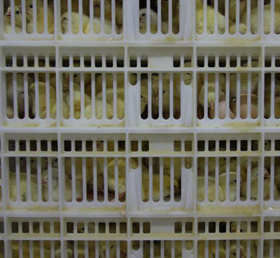Selection for ascites incidence influences hatch window

There is documented association between incubator environment, chick quality and ascites incidence in broilers. Because of this association, one could expect selection for ascites susceptibility to impact hatch characteristics.
A study at the University of Arkansas, Fayetteville, AR, USA, documents hatching times and post hatch growth from broilers derived from lines divergently selected 16 generations for ascites susceptibility under simulated high altitude conditions.
Two one week hatches were incubated under industry conditions. At transfer, all eggs were candled and infertile eggs and eggs containing dead embryos were removed. Beginning at 8 a.m. on day 20 of incubation and continuing in 4 hour increments for up to 36 hours, trays were examined for newly hatched chicks. For each period, newly hatched chicks were banded, weighed, hatching time recorded and returned to tray. The tray was returned to the incubator to stimulate further hatching.
After completion of the 36 hours hatch period all hatched chicks were then reweighed to determine the change in weight during their post hatch time in the incubator. All chicks were reared in a common environment and provided feed and water ad libitum. Weight measurements were taken at 3, 7, 14, 21, and 28 days of age post hatch in order to assess the association between hatch window, line and early growth.
Differences in hatch window times were found between the three lines (Susceptible, Resistant, Relaxed). While all three lines hatched the most birds during the 12-20 hour intervals, the susceptible line on average hatched within 12.4 hr, the resistant 15.9 hr and 16.7 hr for the relaxed line. Chick weight at hatch and at pull were consistent with previous research with resistant higher than relaxed and susceptible line chicks. Selection for ascites susceptibility has altered hatch profile.
Source: Alex Gilley and coworkers, University of Arkansas, Fayetteville, AR, USA; Proceedings of the 2012 International Poultry Scientific Forum, Atlanta, GA, USA












